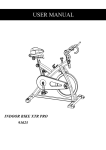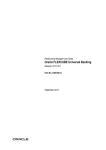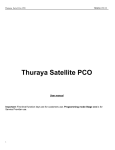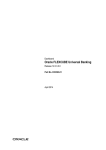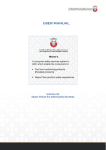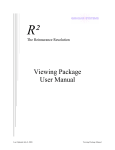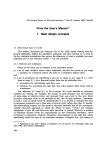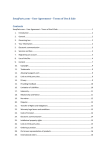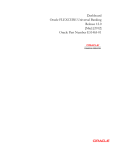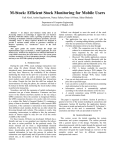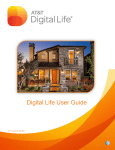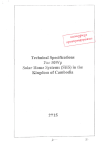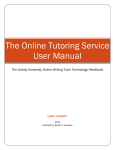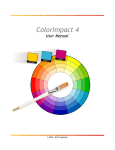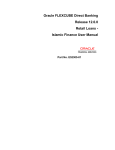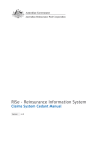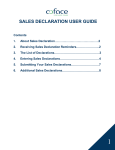Download IA Financial Reporting (eForms) Instructions
Transcript
Insurance Authority United Arab Emirates Financial Reporting Forms (eForms) User Instructions & Guidelines Financial Reporting Forms (eForms) Table of Contents Table of Contents ..................................................................................................... 3 Overview .................................................................................................................. 4 General Directions and Notes .................................................................................. 5 Specific Instructions ................................................................................................. 8 Company Information ......................................................................................... 8 Financial Statements .......................................................................................... 8 Solvency Margin Analysis .................................................................................. 8 Investment Analysis ............................................................................................ 9 Premium Analysis ............................................................................................... 9 Commission & Expense Analysis ....................................................................... 9 Technical Provision Analysis .............................................................................. 10 Reinsurance Analysis ......................................................................................... 11 Related Party Transactions ................................................................................ 11 Takaful Transactions Analysis ............................................................................ 11 Page 3 of 12 Financial Reporting Forms (eForms) Overview This instruction guide is designed to assist in the completion of new Quarterly Financial Reporting Forms (“eForms”) issued by the Insurance Authority. The eForms set out the financial results of the Company for each quarter and calculates the Company’s solvency position. While completing the eForms, Companies should refer to the new Financial Regulations issued by the Insurance Authority as well as the Executive Regulations and the International Financial Reporting Standards (IFRS). All references to “Company” throughout this user manual should be interpreted as pertaining to an insurance company, Takaful operator, reinsurer, foreign branch, etc. as applicable. The forms are divided into the following categories: 1. Company Information 2. Financial Statements 3. Solvency Margin Analysis 4. Investment Analysis 5. Premium Analysis 6. Commission and Expense Analysis 7. Technical Provision Analysis 8. Reinsurance Analysis 9. Payables Analysis 10. Related Party Transactions 11. Takaful Transactions Analysis (Only Applicable to Takaful Companies) Page 4 of 12 Financial Reporting Forms (eForms) General Directions and Notes 1. System Requirements: Excel 2010 or later. Minimum 100Mb of file space and RAM, more recommended. 2. The Excel file contains macros for certain operations. In order to use these macros the Excel security level must be low enough to allow the macros to be enabled when the file is opened. If the macros are not enabled, from the main menu select File | Options to open the Excel Options dialog box, then select Trust Center and then click on the “Trust Center Settings…” button to open the Trust Center dialog box. In the Trust Center dialog box, for the “ActiveX Settings” select the “Prompt me before enabling all controls with minimal restrictions” radio button (or a less restrictive option) and for the “Macro Settings” select the “Disable all macros with notification” radio button (or a less restrictive option) and then click on the “OK” button to save the changes. When you reopen the Excel file you will be asked to enable macros (unless you use a less restrictive option). 3. Some macros assume that automatic recalculation is set to Manual. With larger file sizes Automatic recalculation will slow response times, so we recommend that you make sure recalculation is set to Manual. From the main menu select Formulas | Calculation Options and then select Manual. 4. Before proceeding with data entry, fill in the top boxes and update the reporting period on the Cover sheet in both English and Arabic. Select the Type of Company, Type(s) of Insurance and Type of Registration in the English side only [Arabic will be updated automatically upon recalculation]. Three versions of the Excel file are available, one that can be switched between English and Arabic [Using the Language option in the Cover sheet], one that is locked in English and one that is locked in Arabic. 5. Unless otherwise specified, all information must be entered for the quarter specified in the eForms (as specified in the Cover sheet). By “linking” to data for prior quarters, the year to date or annual figures are automatically calculated and thus, do not need to be entered. The directory path and file names must be entered in the appropriate cells in the Cover sheet and those files must be open in order for the data to be “linked”. 6. The very first time data is entered into the eForms, annual data can be entered in the current quarter. For the next three quarters, the year to date and rolling 4 quarters calculated results may not be correct (depending on which quarter was the first quarter submitted using annual data), but from the fourth onward the year to date and rolling 4 quarters results will be correct. 7. For the year end results, the quarterly results should be entered such that the calculated annual figures match the audited financial statements. Alternatively, annual data can be entered for year end results, but the rolling 4 quarters data will not be correct in future reporting periods. Page 5 of 12 Financial Reporting Forms (eForms) 8. Most sheets are divided into the Property & Liability Fund (Non-life), Insurance of Persons and Fund Accumulation (Life) and Shareholders Fund (Takaful) sections. Data should be entered separately for each fund and should not be combined as the combined results are automatically calculated in the Consolidated Results section. 9. The eForms are designed to be completed by any Company so some sections and lines may not apply. Each Company is only required to fill in the sections, lines, etc. which apply to them. For example, the Life sections do not apply to a Non-Life Company and the Takaful lines do not apply to a Non-Takaful Company. 10. If any of the sheets are not applicable to the Company, please select “N/A” (i.e., Not Applicable) in the “Contents” sheet, noting the reason(s) why. 11. Information about categorizing type of business segments can be found in the sheet named “Guidelines”. This mapping is based on the Executive Regulations. 12. Data entry is primarily limited to direct, assumed and ceded business, with gross and net of reinsurance results being calculated. Reinsurance definitions are as follows: a. Direct Business – Policies that are written directly from the Company to the policyholder. b. Reinsurance Assumed – Policies that are assumed from another ceding Company or policies that are co-insured with another Company(ies). c. Reinsurance Ceded – Policies purchased by the Company in order to transfer risk to the Reinsurer. d. Gross Business – The total of the Direct Business and Reinsurance Assumed. e. Net Business – The Gross Business minus the Reinsurance Ceded. 13. The eForms must be completed in AED in thousand units unless otherwise noted. The input values can be rounded to the nearest thousand dirhams or the portion less than a thousand can be entered as a decimal. For example, 1,234,567 can be entered as either 1,235 or 1,234.567. 14. Amounts denominated in a foreign currency are to be converted to AED in accordance with IFRS. 15. In general, all data should be entered as a positive value so that any negative value should be viewed as “unusual” in order to attract the user’s attention for further investigation. Formulas within the forms will add or subtract as appropriate. 16. For the purposes of geographical analysis: a. The Gulf Cooperation Council (“GCC”) region includes Bahrain, Kuwait, Oman, Qatar, Saudi Arabia and United Arab Emirates. Page 6 of 12 Financial Reporting Forms (eForms) b. The Middle East & North Africa (“MENA”) region includes all of the GCC countries plus Algeria, Egypt, Iran, Iraq, Jordan, Lebanon, Yemen, Libya, Morocco, Palestine, Syria and Tunisia 17. The eForms must be submitted within a period of 45 days from the last day of the stated reporting period (i.e., the relevant quarter). 18. The Solvency Capital Requirement (“SCR”) must be certified by the Actuary. 19. Details of technical provisions must be certified by the Actuary. 20. The eForms, in their entirety, must be authenticated by the External Auditor and endorsed by the Chairman of the Board of Directors. Page 7 of 12 Financial Reporting Forms (eForms) Specific Instructions The following instructions are applicable to each section or a specific sheet(s) within that section. Company Information 1. Only UAE National Companies need to complete the INFO-1 section on Branches. 2. Forms INFO-2, INFO-3, and INFO-6 only need to be completed at year end. 3. In INFO-2, for foreign Companies the “Board of Directors” should be interpreted as the management group with the equivalent governance authority to a Board of Directors. 4. Form INFO-7 replaces the old “Supervision Fees” form. This form must be completed annually and submitted along with the appropriate fees paid to the Insurance Authority. Financial Statements 1. Include the amounts as per the audited financial statements and in accordance with IFRS. 2. For composite companies, assets and liabilities must be separately stated for Non-Life and Life funds. The total of the two funds (Consolidated Results) will match the audited financial statements. 3. For Takaful operators, the policyholder funds and stockholder funds must be entered separately. The total of the funds (Consolidated Results) will match the audited financial statements. 4. In FS-1, the “Share Capital at Group Level” should be for the Company with direct control over the local Branch, not necessarily the Home Office or total group capital. Solvency Margin Analysis 1. Most of the data entry cells in the Solvency Forms are directly linked to other sheets for efficiency of data entry. A few data entry cells do not have a corresponding entry in another sheet, so they must still be entered if appropriate. 2. The discount rate used for valuation purposes to be entered in form “SM-3, Line 16” shall be the interest rate determined by the Actuary. Page 8 of 12 Financial Reporting Forms (eForms) 3. The estimated cash flow for liabilities in form “SM-3” shall be equal to the total undiscounted liabilities as determined by the Actuary. Investment Analysis 1. Investments are categorized according to two different criteria: 1) asset classes and instruments such as equity, debt, real estate, derivatives, bank deposits, etc. and 2) according to IFRS 9 such as investments at fair value through OCI and investments at amortized cost. 2. In Analysis of Derivative Instruments (INV-3), the notional amount is the amount of the derivative instrument’s underlying assets (e.g., stock, commodity, index, etc.) and it is based on this that changes in the value of the derivative instruments are measured. 3. Unrealized / Fair value gains and losses on invested assets must be entered in INV-2, Column (5). 4. Realized gains and losses on invested assets must be entered in INV-2, Column (10). 5. Other earned investment income such as rental income, dividend income and interest rate income is recorded in INV-6. 6. The Ratings Table in INV-7 must be used to categorize investments into the appropriate category. If no rating is available, enter Unrated. This field must not be left blank. 7. The details for each investment in INV-7 are used in several other forms, so all details for each investment are relevant and must be entered if appropriate. Premium Analysis 1. Written premiums by type of business are entered in PRM-1. Earned premiums are calculated by type of business in PRM-2. 2. The exposures in PRM-3 will vary by type of business based on how the policies are rates. For example, for Motor the exposures are typically expressed in car years, for Medical the exposures are typically the number of individuals, for Property types it could be area or value of the properties. 3. Part 2 of PRM-4 only needs to be completed annually as this provides details by Emirate for the annual insurance industry reports. Commission & Expense Analysis 1. All expenses must be directly entered or allocated by type of expense (i.e., the Lines in EXP-1) and insurance operation type (i.e., the columns in EXP-1). Only Page 9 of 12 Financial Reporting Forms (eForms) expenses that do not clearly fall into one of the other types should be included with All Other Expenses (Line 31). 2. The allocation methodology can vary by type of expense in order to most logically allocate expenses by type to the insurance operations. Bases that could be used to allocate expenses include, but is not limited to premium, number of employees, square footage of office space, etc. Once established, the allocation methodology should be consistent from period to period and should not be changed without just cause (i.e., to improve the logic). 3. The total of the expenses by insurance operation type are further allocated by type of business and type of reinsurance in EXP-2, EXP-3 and EXP-4. The allocation methodology must account for all allocations in EXP-1, EXP-2, EXP-3 and EXP-4. 4. Contingent Commissions – All commissions based on performance, such as loss ratio goals, and intended as a form of profit sharing. Technical Provision Analysis 1. Enter details of various technical provisions by type of business in TP-1 (UPR), TP-2 (URR) and TP-4 (OSLR, IBNR, ALAE, ULAE and MATH). 2. Payments and recoveries by type of business are entered in TP-3. 3. Results by Accident Quarter are summarized in TP-5, which pulls data mainly from other Technical Provision forms, but data by Accident Quarter must be entered for Premiums and ULAE. 4. Accident Quarter development triangles are summarized in TP-6, but the details are entered in TP-7, TP-8 and TP-9. Claim count triangles are entered in TP-10. After the original triangles are entered, only the last column of data needs to be entered which updated the data for the current period. Instead of “linking” the prior columns to an older file, a button is included which will copy all of the data from the prior file and shift it by one quarter. 5. To calculate how long Salvage & Subrogation had been outstanding (TP-11), count the number of days since the claim was settled or salvageable item came into possession of the Company. 6. Details in TP-12, TP-13 and TP-14 are only for Life policies. Additional details for Group Life policies are included in other Technical Provision forms. 7. The expected payment streams by type of business must be entered in TP-15. The total of the expected future payments must match the total of the technical provisions. Some of the future payments are entered on a quarterly basis, some on an annual (fiscal) basis and the rest in 5 year periods. The future payments for the Mathematical Reserves must be entered on an undiscounted basis. Page 10 of 12 Financial Reporting Forms (eForms) 8. Claim payments and technical provisions by region are detailed in TP-16 and TP17, respectively. Part 2 of these forms which provide details by Emirate are only required to be submitted on an annual basis. 9. For TP-18, the number of policies are only those which are subject to the National Ambulance program (i.e., Motor). The Written Fees are the full fees charged to customers (typically AED 50 per policy), adjusted for cancelations, etc. during each 3 month period. The Earned Fees are the pro-rata share of the Written Fees earned to date – i.e., the Earned Fees will increase over time until they are equal to the Written Fees after all policies have expired for that 3 month period. The Cumulative Expenses are the charges paid to the program for the policies in question. Reinsurance Analysis 1. Reinsurance recoverable (REINS-1 and REINS 3) refers to the ceded portion of the Company’s claims that can be recovered from reinsurance companies. It is stated as reinsurance contract assets in the financial statements. 2. Reinsurance receivable (REINS-2) refers to payments due from reinsurance companies that has already been invoiced to them and is termed as outstanding. Related Party Transactions 1. List only the largest 10 transactions with the Company’s related parties during the year. All other transactions may be combined into “Others” in Line 11. 2. Nature of the relationship refers to the criteria or basis on which the Company has been deemed as a related party. Examples include: parent, subsidiary, key management personnel, owned by the same group, etc. 3. Nature of the transaction must detail the reason for the transaction. Examples include: premiums written, claims paid, loans provided, dividend payments, etc. Takaful Transactions Analysis These forms are applicable to Takaful operators only. 1. All transactions between the participants’ fund and the shareholders’ fund must net to zero at the end of the period. 2. Deferred Wakala and Mudaraba expenses refer to Wakala/Mudaraba fees that have not been incurred yet. 3. Deferred Wakala and Mudaraba fees recorded in the participants’ fund must equal the Unearned Wakala and Mudaraba fees in the shareholders’ fund. Page 11 of 12 Financial Reporting Forms (eForms) 4. ‘Loans to participants’ from TAKF-3 must be equal to ‘Qard Hassan from Shareholders’ in TAKF-2. Page 12 of 12












